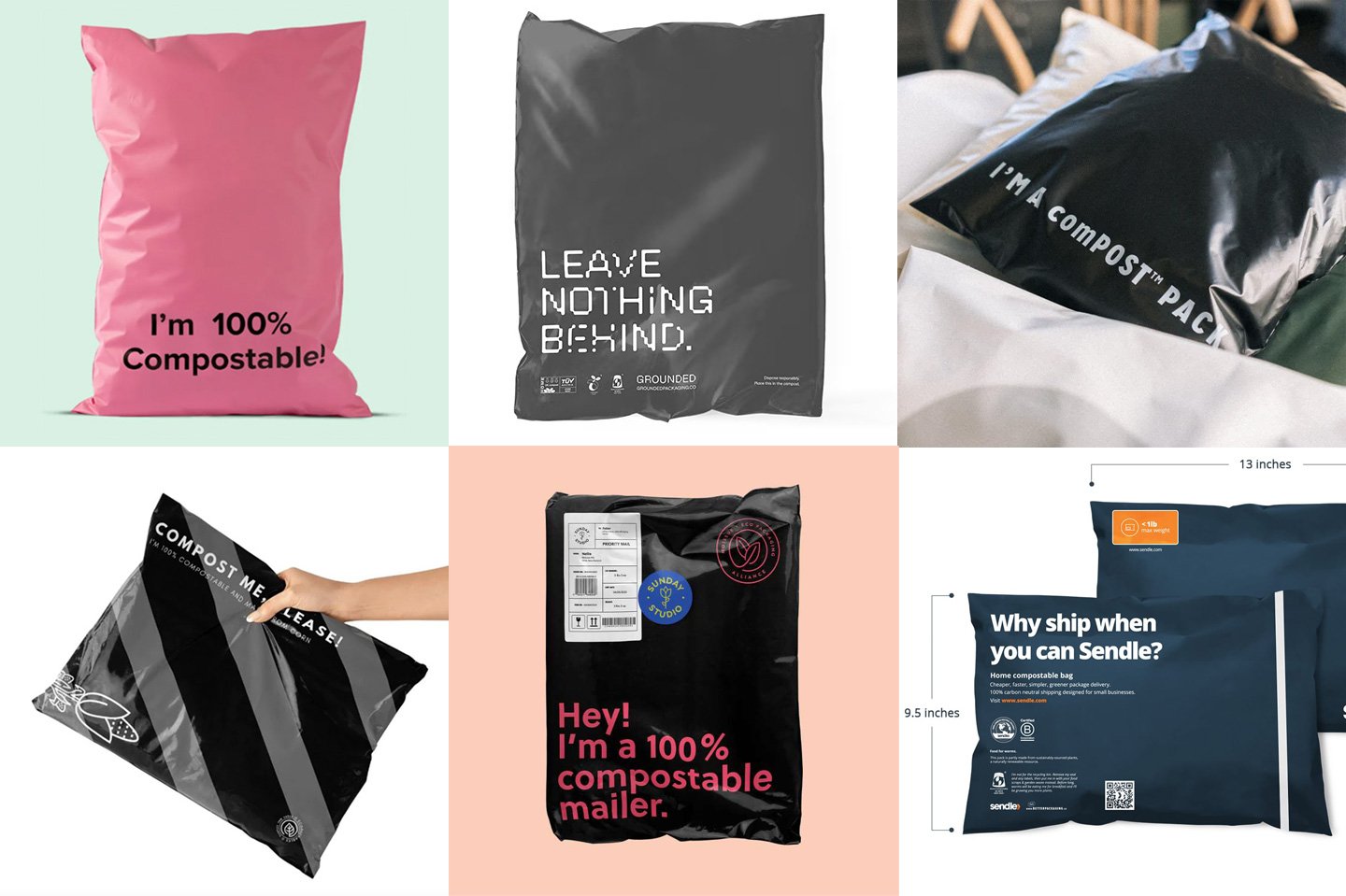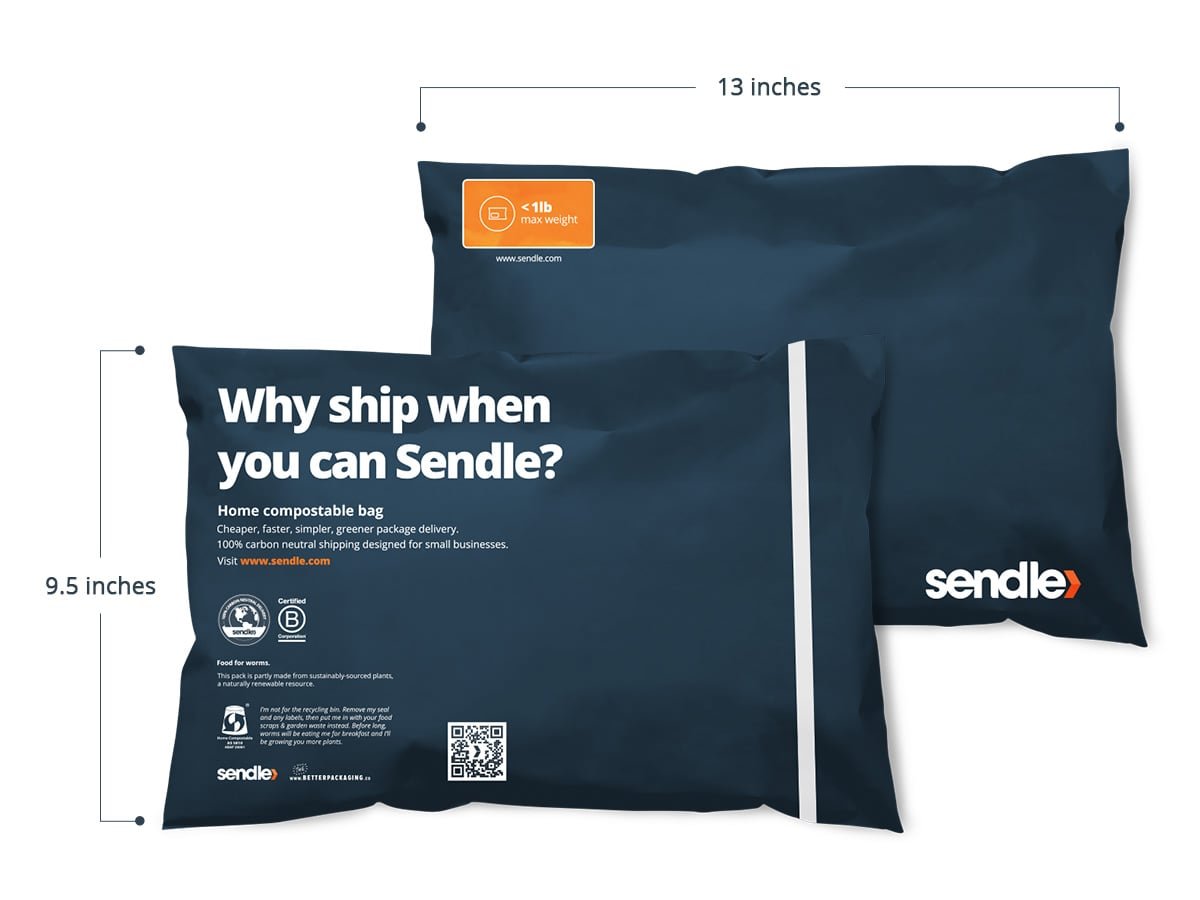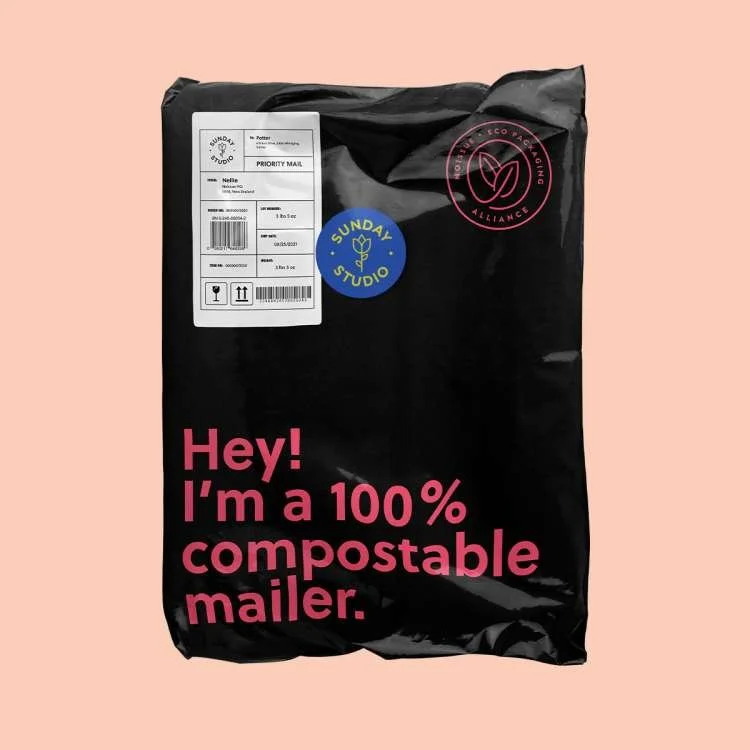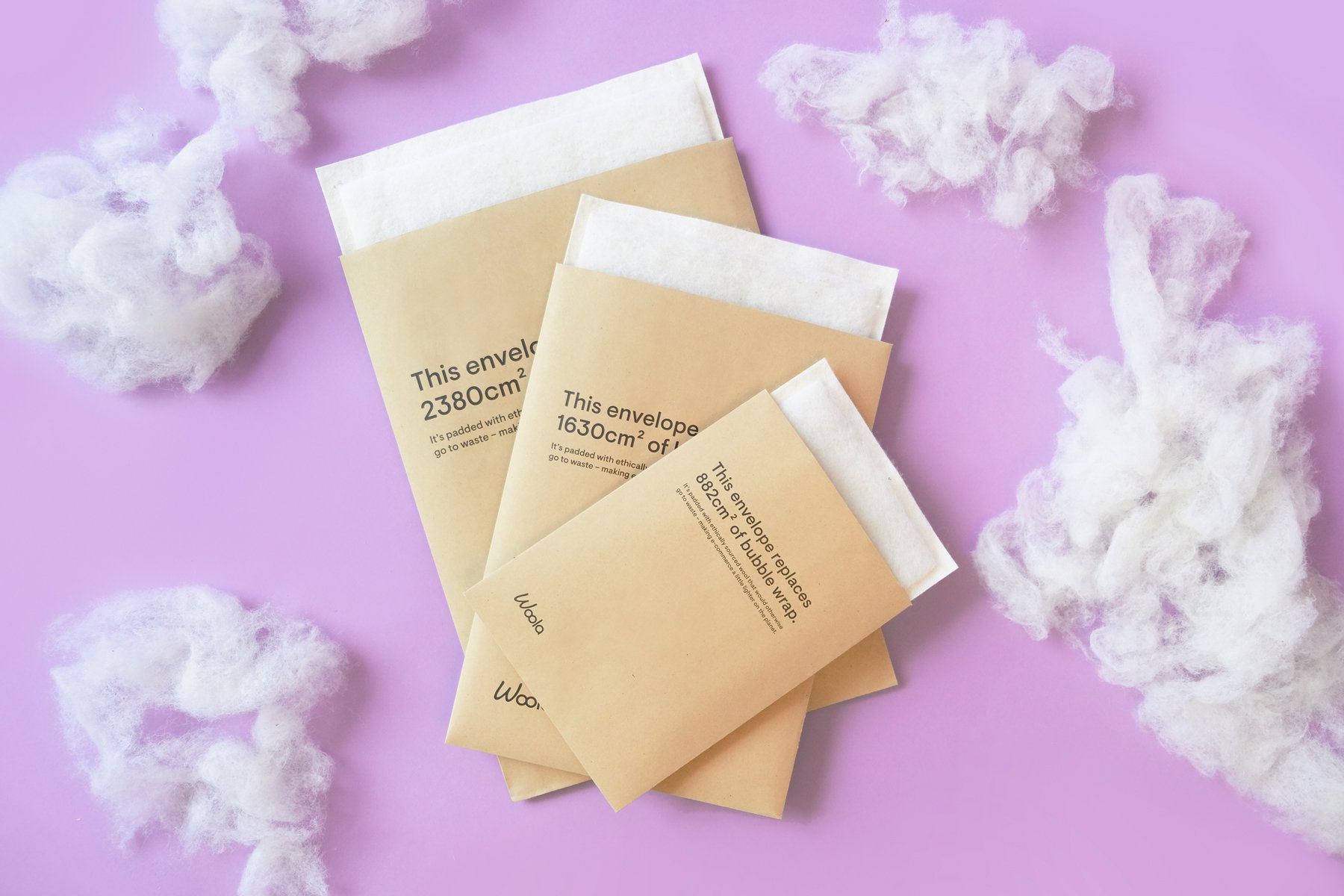Compostable mailing bags: everything you need to know
Last updated: September 17, 2024
For decades, plastic packaging like polymailers and bubble wrap have been the dominant option for shipping products. Although inexpensive and effective, plastic takes up to a thousand years to degrade and causes harm to the Earth’s ecosystem in many ways.
Every year, about 8 million tons of plastic waste enter the oceans from coastal nations, according to National Geographic. This plastic kills thousands of sea and land creatures by entanglement and ingestion.
Humans also consume microplastics in their drinking water and food—leading to inflammation-led health conditions like cancer. Additionally, plastics are made from fossil fuels in a process that exacerbates global warming and Earth’s climate change issues.
As more people understand the environmental impact of plastics and microplastics, many are looking for recyclable or even compostable packaging.
Choosing compostable postage bags as your ecommerce packaging is one way to reduce plastic use and appeal to customers looking to shop more sustainably.
What are compostable shipping bags made of?
Compostable alternatives to poly mailers can be made of different materials including:
Bioplastics
Recycled paper
Virgin paper
As bioplastics are the most common option, let’s take a look at those first.
A word of caution about bioplastics [Read this before buying]
PBAT (polybutylene adipate terephthalate) and a plant-based polymer PLA (poly lactic acid) are usually combined with corn starch to produce bioplastics. Although bioplastics are degradable, they are not always biodegradable. Effectively, this means that the material can be industrially composted but not composted at home.
Perhaps you’ve never heard of industrial composting before? Well, you’re not alone. Most consumers don’t have easy access to industrial composting facilities and as such don’t know much about the process.
Industrial composting is a multi-step, closely monitored composting process with measured inputs of water, air, as well as carbon and nitrogen-rich materials. These measures ensure biodegradation of the organic material to high quality, toxic-free compost.
If a mailer is industrially compostable, not at-home compostable, then you should consider whether your customers have access to industrial composting facilities. In Europe, for example, they are few and far between.
Home composting typically happens in a backyard compost barrel or a home compost bins over a period of months.
It’s important to note that some companies claim their mailers are “100% compostable,” without clearly communicating whether they require industrial composting or whether they are safe for at-home composting.
A recent study showed that consumers are confused about the meaning of the labels of compostable and biodegradable plastics. Even worse, the study found that most plastics marketed as “home compostable” don’t actually work, with as much as 60% failing to disintegrate after six months.
If you’re still interested in bioplastic packaging that’s at-home compostable, look for proof in certificates (the most common is TUV’s OK home compost) and if possible, double-check the certification database that they have this certificate.
Besides the compostability and certification issues, compostable bio-based poly mailers have some other downsides when it comes to the big picture of sustainability.
Most are made with corn starch and PLA derived from corn kernels. This means that large quantities of corn (often genetically modified) are produced using pesticides, herbicides, and other non-sustainable processes. After corn kernels are used, the rest of the corn is also typically discarded.
So, you’ve been warned about the issues with compostable mailers made with bioplastics. You can skip to paper-based options or keep scrolling if you still want to consider using bioplastic mailers.
1. Wastebased compostable mailer
This compostable mailer is also made of bioplastics and corn starch. It’s thin and sleek and can accommodate stickers and stamps. Wastebased assures customers that it can be home-composted in 6 months.
You’ll appreciate that this mailer can handle the elements, being water-proof, durable, and tamper-proof. It’s also opaque, so you can keep your package’s content private.
However, it’s not padded, so we wouldn’t recommend it for fragile items. The glossy surface will also likely cause some ink smudging, and it also has other issues common to bioplastics.
2. Grounded compostable mailer
Grounded’s compostable mailer bag offers a few different variations to choose from. One option is the Compostable PHA film material one, and the second uses Home compostable bioplastic film.
They are durable and you also have the option of double adhesive strips for re-use. You can also fully customise the mailers with gravure printing if you order a minimum of 10,000 units.
3. Sendle compostable mailer
Sendle also makes compostable mailers from corn starch, PLA, and PBAT. The mailers look and feel a lot like plastic. They’re durable, tear-resistant, and have a bit of stretch.
One major downside is that these mailers come in one size only; they’re available in 13" x 9.5" packages. They’re also not padded, so they would be best for shipping products that don’t need cushioned protection.
4. Better Packaging’s comPOST Packs
Better Packaging also calls these “The original Real Dirt Bags”– they are OK Home Compost certified, fully biodegradable mailing satchels partly made from plants. The comPOST packs are available in an impressive range of sizes from XS to UBER TR.
Still, as bioplastics, the packaging is made from corn starch, PLA, and PBAT. However, Better Packaging states that the comPOST Packs are free from GMO material.
5. noissue Compostable Mailer
Like most compostable bio-based poly mailers, this packaging option is made of a combination of bioplastics PBAT and PLA and corn starch.
noissue guarantees customers that its compostable mailer composts within 180 days at home and 90 days in a commercial compost. It has a 9-month shelf life and comes with reusable adhesive strips.
This packaging option is attractive and can be customised to match your brand. Just keep in mind that the bioplastic component comes with unique sustainability issues.
6. Tishwish compostable padded mailer
Tishwish’s compostable mailing bags are made from PBAT, corn starch, and PLA. The mailers are visually appealing and can be customised as needed. They’re also water-resistant, flexible, and reusable.
Tishwish states that their compostable packaging has been certified by TUV Austria and ABA as being home and commercially compostable. Unfortunately, they’re only available in two sizes.
7. Ecopackables compostable polymailer
This polymailer is also made from PLA, PBAT, and corn starch, but Ecopackables reports that that only use discarded corn for cornstarch production, which reduces the mailer’s carbon footprint.
It’s available in five different sizes and customisable colors with printable and sealable sides. However, this is a non-padded mailer.
Wool and Recycled Paper
Wool is a natural, biodegradable resource, which, when ethically sourced, is a sustainable alternative to poly mailers.
8. Woola Wool Envelopes
At Woola, we make packaging out of leftover wool from farm-grazed sheep—wool that would otherwise go to waste. Our Wool Envelopes comprise two layers made from paper and wool.
The outer layer is made from recycled paper, which you can customise with your branding, while the inner layer is made from wool. We use a bio-based biodegradable binder to turn raw wool into Woola packaging.
Our Wool Envelopes are designed to be sturdy, water-repellent, and temperature stable to protect your goods.
Unlike poly mailer bags, our Wool Envelope is completely degradable and can be industrially composted. By the end of 2022, we’ll be getting rid of the bio-based binder in our production, so we’ll be using only wool in the inner layer, making it compostable at home.
Woola packaging stands out, not just for its sustainability but also because they look good and help you run a more sustainable business. If you’d like to try one of our envelopes, we offer free samples.
“A bonus: Glassine bags”
Made from wood pulp responsibly sourced directly from forests, this translucent material is biodegradable, moisture resistant, and usually used for internal packaging.
9. Glassine bags by Ecoenclose and Vela
These glassine bags are completely plastic-free and are made from FSC-certified virgin paper. They come in various sizes for your packaging needs.
These bags are also acid-free and designed to withstand the rigors of shipping. They’re glossy to the touch, humidity-resistant, and easily scannable. If you’re looking for a recyclable option, you’ll like that these can be recycled curbside and are 100% biodegradable.
If you don’t like the translucent look or are looking for packaging that’s meant for shipping, these will probably not work for you.
10. Better Packaging glassine garment bags
Similar to Ecoenclose and Vela’s, Better Packaging makes glassine bags that are totally plastic free. These bags are durable and easy to write on. They’re also water and tear-resistant, which makes them a solid internal packaging option.
Better Packaging makes it easy to re-use these bags with the addition of a resealable component. Because they’re made of paper, the bags can be recycled curbside, are home-compostable, and biodegradable over a period of months.
Again, it’s largely transparent—which may not be brand consistent—and offers little to no padding. It also looks a lot like plastic, which could be off-putting for customers choosing a more sustainable look and feel.
Choose mailers that are actually compostable
As sustainability is an increasingly important topic in the world of ecommerce, retailers and consumers alike are looking to replace plastic packaging.
Compostable mailers can be tricky because the field is still developing, and we are continuously finding out more about the impact of some newly-popularised materials like bioplastics. Still, compostable packaging—especially those made of sustainable materials and certified for at home composting—always beats plastic use.
Woola’s Wool Envelopes are a protective option, aesthetically pleasing and unique for every brand looking to stand out and delight its customers. If you want to get a feel of our packaging, you can request samples here—they’re free for businesses!












